Top News
January 25, 2017 Ryukyu Shimpo online edition
On January 25, the Nago City Council voted on a written statement and protest resolution objecting to the resumption of Osprey flight training while there has yet to be sufficient investigation into the cause of the Osprey accident that occurred in Abu, Nago, in December last year. The statement and resolution, which contain four demands including suspension of Osprey flight training and aerial refueling training exercises, was adopted by majority vote. Also included in the demands were that the U.S. Marine Corps retrieve all of the wreckage from the vicinity of the Osprey crash site, remove Osprey from Okinawa, and cease Henoko base construction where Osprey would be deployed.
There were 15 votes in favor of the statement and resolution in total: 13 from the council’s ruling party faction and 2 from the Komeito faction. In total 11 votes were cast against, all from the council’s opposition party members. The written statement is addressed among others to the prime minister, the minister for foreign affairs, and the minister of defense; the protest resolution is addressed to the U.S. ambassador to Japan and the commander of the U.S. Forces Japan, among others. These documents point out that the US military has gone against its word by resuming Osprey flight training. It furthermore says that Okinawans absolutely cannot accept that Japanese government’s stance of prioritizing military affairs and the preferences of the United States while Okinawan citizens’ lives and property are trampled underfoot.
(English translation by T&CT and Erin Jones)
Go to Japanese
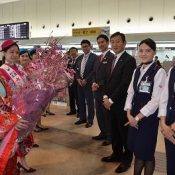
January 20, 2017 Ryukyu Shimpo
As the January 21 opening day of Motobu Yaedake cherry blossom festival approached, the Japan Airlines Okinawa branch and Japan Transocean Air sent thirty bundles of Ryukyuan Taiwan cherry blossoms from Yaedake to twenty-two airports across Japan on January 20. The air companies have sent the cherry blossoms twenty-three times including this shipping. The cherry blossoms will be displayed at check-in counters and lounges at the airports.
During the shipping ceremony held on the morning of January 20, Nago Cherry Blossom Queen as well as the King and Queen of Hokuzan from Nakijin, which are also sites for cherry blossom festivals, joined the Motobu Miss Cherry Blossom to hand bouquets of cherry blossoms to the JAL branch manager Katsuma Watabe and the JTA chief executive Kiyoshi Marukawa.
Chairperson of the Motobu town tourism association, Kiyohiro Toyama, greeted people saying, “I hope people will feel the warmth of Okinawa through the cherry blossoms from the islands where the trees are first to open up in the country, and I hope many visit Okinawa.”
(English translation by T&CT and Sayaka Sakuma)
Go to Japanese

January 23, 2017 Ryukyu Shimpo
On January 22, 77-year-old Masumi Okunishi from Haebaru Town spoke about Osprey in front of a full audience at the Ryukyu Center of the East Asian Community Institute (EACI) in Naha. The former Air Self-Defense Force (ASDF) pilot made and presented a picture-story show from a pilot’s perspective, conveying the dangers of Osprey.
During his presentation he said that an Osprey in transition from helicopter mode to airplane mode cannot be adequately described as a helicopter or a fixed-wing aircraft. He raised the point that it is dangerous should engine trouble occur during transition.
Okunishi served in the ASDF for 16 years as an F-104J Starfighter test pilot, among other things. Following his ASDF service he went to work as a pilot for a private airline company, accumulating 41 years of experience as a pilot. He does not pilot Osprey or helicopters.
Last year in October Okunishi used pictures to describe the dangers Osprey pose at a moai (social cooperative group) that he attends. Because people liked his description, he made it into a story-picture show.
Through the story-picture show he explained how the shape and angle of Osprey propellers produce lifting power. He said that during transition the angle of the propellers change with each propeller rotation, causing the whole aircraft to tilt. Also, he emphasized that no one can describe what is happening to the angle of the propellers during transition.
This picture-story show will be presented again at the January 29 regular meeting of the EACI.
(English translation by T&CT and Erin Jones)
Go to Japanese
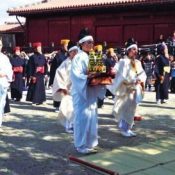
January 22, 2017 Ryukyu Shimpo
A Ryukyu dynastic era ritual, Momoso-omonomairi, was re-enacted on January 21 at Shuri Castle Park in Shurikinjocho, Naha. Priestesses made a pilgrimage to the sacred site in the castle grounds, praying for things such as a long life for the emperor, safe sailing and bountiful harvests. A large number of spectators watched the solemn, mostly-female ceremony. The ritual was observed again on the 22nd.
In the Ryukyu Dynasty era, the ceremony was said to be observed around six times annually. High priestesses from Ooamushirare in Mihira and representatives from the dynastic government, around 30 people in total, would depart from the castles inner garden, or Unah, and pray at the Suimui Utaki in the lower garden, or Shichaunah. After this the priestesses would make a pilgrimage to the Kyo-no-uchi, which was off limits to men.
The unique atmosphere of priestesses singing a ceremonial song while making the pilgrimage gave spectators a taste of a culture that differs greatly from modern Japan. One spectator from Hyogo, 32-year-old Yukiko Fukada, said, “The ceremony had a holy feel to it.”
(Translated by T&CT and Sam Grieb)
Go to Japanese
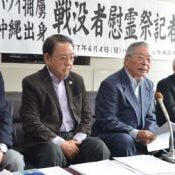
January 20, 2017 Ryukyu Shimpo
On January 19, a memorial service will be held for Okinawans who died in a Hawaii POW camp. The committee organizing the service held a press conference at the Okinawa Prefectural Government office and announced the plan to hold the memorial event for Okinawans who were transferred from Okinawa in 1945 to Hawaii as war prisoners. The committee invited people from the prefecture to participate in the memorial service, which is scheduled to be held on June 4 on the Island of Oahu, Hawaii.
A co-representative of the committee, Hikonobu Toguchi was held in the camp on Oahu from July 1945 to December 1946. He looked for the graves of Okinawans when he returned to Hawaii after the war; however, he could not find any. Toguchi has obtained a record of 12 Okinawans noted as dead and made an inquiry with the U.S. about the location of the remains.
According to a Ryukyu Shimpo article published on November 30, 1983, the dead were buried in the U.S. military Schofield Barracks, but the graves were removed in 1946 in accordance with the expansion work. There is no record of the remains of Okinawans being returned to Okinawa.
The Executive Committee will hold a memorial service at 3 p.m. on June 4 at the Jikoen Hongwanji in Honolulu. Toguchi said, “It is the role of the living to comfort the souls of those who must have been wandering in the sky of Hawaii. I hope many people come to know about this.” The committee called for participation and donations for the memorial service. For inquiries, call the Executive Committee at 098 (887) 0016.
The names of the unidentified Okinawans are as follows:
Shinso Akamine (Deceased on July 22, 1945); Ryokotoku Ishikawa (Civilian Military, Deceased on September 12, 1945); Anso Asato (Deceased on August 10, 1945); Seitei Ganaha (Civilian Military, Deceased on July 31, 1945); Noritaka Tanaka (Civilian Military, Deceased on December 2, 1945); Jiro Miyazato (Civilian Military, Deceased on August 10, 1945); Seikei Yamashiro (Civilian Military, July 22, 1945).
(English translation by T&CT and Megumi Chibana)
Go to Japanese
January 20, 2017 Ryukyu Shimpo Digital Edition
(Tokyo) On the afternoon of January 20, Prime Minister Shinzo Abe gave his policy speech to the plenary session of the House of Representatives. Regarding the construction of a new base in Henoko, Nago City in conjunction with the relocation of U.S. Marine Corps Air Station Futenma, Abe emphasized, “in accordance with the Supreme Court’s ruling, we will proceed with relocation work off the coast of Henoko, Nago City.” Abe also stated, “In the past, it was said that the base should be relocated ‘at least’ outside of Okinawa, but this did not pan out, and all that was left was disappointment. No amount of bold assertions can change reality in the slightest. We will move forward with what is necessary. We will produce results.” Abe’s comments referred to the Democratic Party of Japan administration in 2009 and made his position of promoting the new base construction clearer than ever.
In addition, Abe’s speech promoted strengthening the U.S.-Japan alliance, but also emphasized measures the government has taken to reduce the base burden on Okinawa, such as the return of part of the Northern Training Area and the execution of a supplemental agreement to the Status of Forces Agreement (SOFA) clarifying the scope of U.S. military-related persons who have SOFA status.
In relation to Okinawa revitalization, Abe said, “Okinawa is a bridge to Asia. It is our country’s gateway to tourism and distribution.” He expressed his intention to support improvements to the New Ishigaki Airport, which is being used by an increasing number of tourists from overseas, so that it can handle larger aircraft.
(English translation by T&CT and Sandi Aritza)
Go to Japanese
January 20, 2017 Ryukyu Shimpo
On January 19 at a meeting of the Inter-Ministerial/Agency Co-ordination Committee (IMACC) for World Natural Heritage, the Japanese government decided to formally nominate an area that spans parts of Kagoshima and Okinawa Prefectures as a Natural Heritage candidate site with the United Nations Educational, Scientific and Cultural Organization (UNESCO) World Heritage Centre. This site is comprised of Amami Oshima, Tokuno Island, a northern part of Okinawa Island, and Iriomote Island.
Now, the nomination file must be submitted to UNESCO through a Cabinet decision by February 1. After that, advisory bodies to UNESCO will carry out examinations around autumn this year, and the World Heritage Committee will make a decision on whether to include the site on the World Heritage List at earliest in summer 2018. An official of the Ministry of the Environment said that the IMACC believes that all the conditions for UNESCO registration have been satisfied.
The candidate site is about 37,946 hectares in total. Regarding the region’s “remarkable universal value” as a World Heritage site, the IMACC says that the candidate site is home to unique biological development that occurred during the process of island formation, and that it is an area in which it is important to conserve biodiversity represented by endemic species that are rare worldwide.
As of 2015 the International Union for Conservation of Nature (IUCN) Red List of Threatened Species included 86 endangered species of flora and fauna (70 of which are endemic to the area) living and breeding on the candidate site, such as the Iriomote cat, Amami rabbit, and Yambaru-kuina (Okinawa rail). As measures for protection [of these endangered species], the government is promoting countermeasures against mongoose and other nonnative species, promotion of ecotourism, appropriate monitoring and use of information, and the like.
In addition to the Natural Heritage candidate site, the IMACC decided to formally nominate areas of Nagasaki and Amakusa as a Cultural Heritage candidate site. These areas harbored early Japanese Christianity back when Christians had to conceal their beliefs.
(English translation by T&CT and Erin Jones)
Go to Japanese
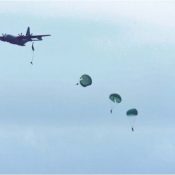
January 13, 2017 Ryukyu Shimpo
The U.S. air force conducted parachute drop training over the Tsuken Island training area in Uruma City around 11:00 a.m. on January 12. The training was done without any notification being given to Okinawa Prefecture or the city. Soldiers as well as supplies were dropped. There were some fishing ships sailing around the same area. The prefecture and Uruma City Have demanded training be conducted in the ocean only around Ie Island area based off the report by the Specian Action Committee on Okinawa, so called SACO, yet the request was once again ignored. On January 11, the U.S.FederalAviationAdministration(FAA) announced multiple trainings will be held in the U.S. Kadena Air Force Base on January 17. However, the notification was deleted on January 12. This marks the eighth training conducted offshore of Tsuken Island since the SACO agreemend was made. The previous training was done in August of 2015.
Seven parachutes were dropped from US Air Force MC130 special operation task force at 11:07 a.m. Six out of the seven items were soldiers, and two parachutes were attached to the last item. The soldiers got on a boat to sail around the area for about three and half hours before they landed on White Beach. Black materials were considered to be the boat that the soldiers used.
It is mandatory for the U.S. military to notify the Okinawa Defense Bureau about training around the area in advance. We asked the US Marine Corps and Navy about the reason for not notifying the prefecture as well as the reason for the training around Tsuken Island, however no answer was given by January 12.
However, the U.S.FAA posted on its website, “The U.S. military will conduct multiple drop trainings in Kadena Air Base from 3000 meters above the base. There will be a restriction on the two runways in Kadena Air Base from 6:00 a.m. to 9:00 a.m. and 12:00 p.m. to 2:00 p.m. due to the drop training.” However, the post has been deleted as of January 12, 7:00 p.m. local time.
The local communities have urged the Defense Bureau to provide the details of the training yet received the answer, “no details available.”
(English translation by T&CT and Sayaka Sakuma)
Go to Japanese
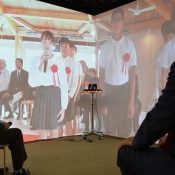
January 17, 2017 Ryukyu Shimp
On January 10, the Okinawa Prefectural Government (OPG) held a ceremony at the OPG Hall and DiDiYonaguni Interchange Hall in Yonaguni to commemorate the completion of the remote island telecommunication infrastructure improvement project which connects Okinawa Island and neighboring islands by an optical undersea cable. As the ceremony proceeded, it was televised in both venues on a large screen using the optical cable.
The connection of Okinawa Island and selected remote islands by the optical cable means high-speed broadband is now available for residents. Governor Takeshi Onaga said, “We will continue to improve the fiber-optic network in each island. Improving Wi-Fi services will promote various areas such as tourism, disaster prevention, medical services, distance learning and so on.”
(English translation by T&CT and Megumi Chibana)
Go to Japanese
January 17, 2017 Ryukyu Shimpo
Governor Takeshi Onaga is scheduled to visit the United States from January 30 to February 5, according to an announcement from the Okinawa prefectural office on January 16.
The Trump administration will be inaugurated in the United States on January 20. Before the administration decides on its policies, Onaga aims to convey the Okinawa government’s stance on the construction of the new U.S. base at Henoko in Nago, seeking a review of the plan to build a replacement facility in Henoko for the Marine Corps’ Futenma air base in Ginowan City.
The prefectural office is working to make arrange meetings with the new U.S. government officials, the members of the U.S. congress and think tanks that can influence the government’s security policy.
The governor is scheduled to leave Naha Airport on the afternoon of January 30 and will arrive in Washington D.C. on the morning of January 31.
On February 2 at The George Washington University, Onaga will give a lecture on the Okinawa base issue and Moritake Tomikawa, a policy adviser to the prefectural government and a former professor of Okinawa International University will give a talk about the relationship between economics and the base issue.
Nago Mayor Susumu Inamine and president of Kanehide Group Morimasa Goya, who are co-representatives of the All Okinawa Council which aims to never allow the new base to be built, will visit Washington D.C. with the governor.
Kiichiro Jahana, the head of the Executive Office of the Governor, said, “Conveying the prefectural stance to the United States congress members and key figures when the new U.S. movement’s policy is about to be formed will be an effective approach. Staff members employed by the new administration may want information from outside sources.”
He added, “The Supreme Court ruled against the governor’s attempt to block the landfill work. However, it is important to convey to the new U.S. administration, the prefectural government’s policy on not allowing the new base in Henoko to be built.”
(English translation by T&CT)
Go to Japanese

On January 14, the Okinawa Defense Bureau (ODB) of the Ministry of Defense began to install new floats with protuberances on the ocean in relation to the Futenma Air Station relocation plan and the plan to construct a new base in Henoko, Nago. These floats, prepared by the ODB, have protruding rods that appear to be metal. Rope is strung between these rods, which stick up above the water. It seems that these floats are being used as an above-water fence to keep out citizens’ protest boats and canoes. If citizens cut these ropes, the Japan Coast Guard could potentially make a property damage cases against the perpetrators.
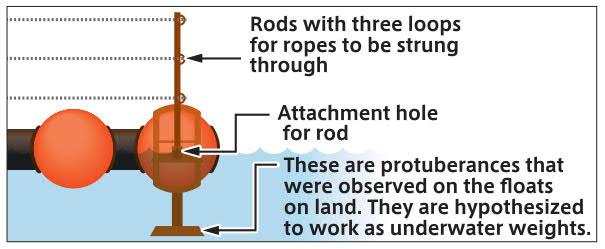
These new floats have protuberances that sit underwater. Because the protuberances, to which plates and rods are attached, cannot be seen above the water, it appears they are being used as weights beneath the water. Upward rods are erected about three flotation spheres apart from each other, and each has three loops through which rope can be strung parallel to the surface of the water.
People are voicing their concerns about the metal rods, pointing out that they pose dangers to citizens opposing base construction in Henoko. Criticism against the Japanese government’s unbending stance toward hastening construction seems to be piling up.
When asked about the use of the new floats in an interview with Ryukyu Shimpo on January 12, the ODB answered that the floats are for no other purposes than to mark the boundary of a temporarily restricted area and absolutely ensure work safety. The ODB did not clarify the purpose of the above-water fencing or other specifics.
Past 3:00 p.m. on January 14 the OBD had set up three strands of the new floats, each of which measures about 100 meters in length. The floats were attached by wire to large, submerged concrete blocks. At that time there were still many floats remaining on the sandy beach, and more being brought in by truck. It appeared that installation work of the above-water fencing would continue into the next day.
Citizens took 3 protest boats, 1 inflatable boat, and 11 canoes out to protest on January 14. The Japan Coast Guard restrained one protest boat for a short duration. Starting at 7:00 a.m. on the same day, citizens engaged in a sit-in protest against construction of a new base near Camp Schwab’s gate in Henoko, Nago. At most about 90 people participated in the gate-front protest.
(English translation by T&CT and Erin Jones)
Go to Japanese








 Webcam(Kokusai Street)
Webcam(Kokusai Street)


